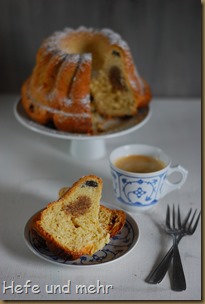 It is already middle of January, but I still have two Recipes from christmas waiting. The first one is the recipe for a spelt panettone. Baking panettone or pandoro on the 23. December is already a kind of tradtion here at “Hefe und mehr”. In the weeks before, I take intensivly care of my sweet starter to make it especially fit for the task.
It is already middle of January, but I still have two Recipes from christmas waiting. The first one is the recipe for a spelt panettone. Baking panettone or pandoro on the 23. December is already a kind of tradtion here at “Hefe und mehr”. In the weeks before, I take intensivly care of my sweet starter to make it especially fit for the task.
As baking Panettone is already nearly a no brainer. And so I was looking for a new challange. Switching from wheat to spelt is definitly more challenging, as kneading the sensitive spelt to full gluten development needs experience. And it is a good idea to check which sort of spelt you use. Different spelt sorts behave differently as their gluten composition differs. For Example if you use Oberkulmer Rotkorn you need to shorten the kneading time compare to Franckenkorn, which I used here. But with these in mind, baking panettone with spelt works very well. Just keep a close eye on the gluten development.

![Osterbrot (3)[3] Osterbrot (3)[3]](https://www.hefe-und-mehr.de/wp-content/uploads/2017/04/Osterbrot-33_thumb.jpg)
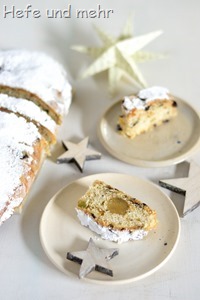 Spelt is a favourite and so I was regulary asked if my Stollen can be baked with spelt flour, too. I answered “theoretically yes” and decided to bake a Stollen with spelt flour instead of wheat, too. I like to have a practical background for those answers.
Spelt is a favourite and so I was regulary asked if my Stollen can be baked with spelt flour, too. I answered “theoretically yes” and decided to bake a Stollen with spelt flour instead of wheat, too. I like to have a practical background for those answers.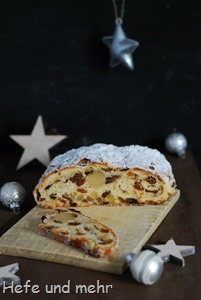 Last year I saw a
Last year I saw a 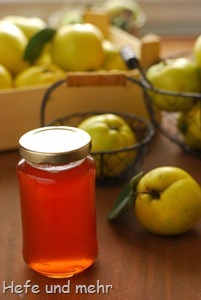 When the quinces turn golden in my parents garden then we are in the middle of autumn. And our flat is filled with the rich perfume of the fruits as I tend to place them strategically in living room and kitchen to enjoy my favourite autumn flavour as much as possible.
When the quinces turn golden in my parents garden then we are in the middle of autumn. And our flat is filled with the rich perfume of the fruits as I tend to place them strategically in living room and kitchen to enjoy my favourite autumn flavour as much as possible.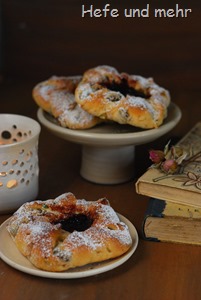 I can not tell how I learn about the Reformationsbrötchen (reformation rolls). But the idea somehow stuck in mind and so I had to bake them just in time for the 31. October (Reformation day).
I can not tell how I learn about the Reformationsbrötchen (reformation rolls). But the idea somehow stuck in mind and so I had to bake them just in time for the 31. October (Reformation day).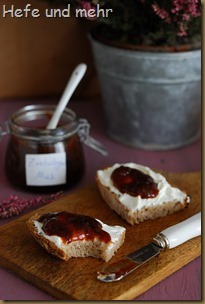 Since three years I use my Slowcooker to cook plum butter. This is very relaxed as I just have to remove the plum pits the night before and turn on the slow cooker. I put the lid on the cooker in a right angle, leaving a gap so the evaporated water can escape. After 12 hours cooking on “High” the juice has reduced a good deal and after pureeing it needs another three to four hours until it reaches the perfect thick consistence.
Since three years I use my Slowcooker to cook plum butter. This is very relaxed as I just have to remove the plum pits the night before and turn on the slow cooker. I put the lid on the cooker in a right angle, leaving a gap so the evaporated water can escape. After 12 hours cooking on “High” the juice has reduced a good deal and after pureeing it needs another three to four hours until it reaches the perfect thick consistence.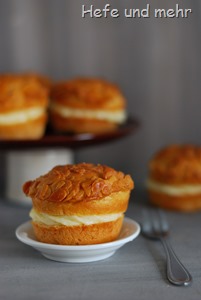 “Bienenstich” is a traditional german cake and its name literally means “bee sting”. For me it is a classical cake to serve on Sundays together with some coffee. When my parents visited us last sunday, I decided to make some muffin sized little Bienstich. Their dough is a “sibling” of my actual
“Bienenstich” is a traditional german cake and its name literally means “bee sting”. For me it is a classical cake to serve on Sundays together with some coffee. When my parents visited us last sunday, I decided to make some muffin sized little Bienstich. Their dough is a “sibling” of my actual 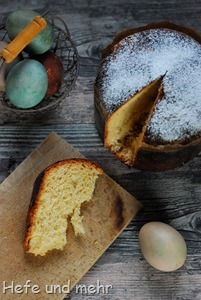 Sometimes you stumble over a recipe and then it catches you so much, that you change all your plans just to bake it. For me this happend when I read about the Schiacciata di Pasqua, the Tuscan Easter bread similar to Panettone. It is baked with olive oil, what tempted me very much. And because I was feeding my
Sometimes you stumble over a recipe and then it catches you so much, that you change all your plans just to bake it. For me this happend when I read about the Schiacciata di Pasqua, the Tuscan Easter bread similar to Panettone. It is baked with olive oil, what tempted me very much. And because I was feeding my 